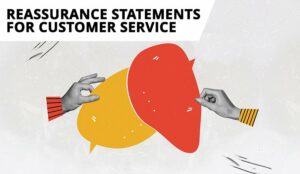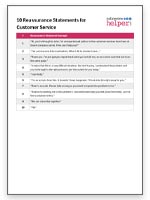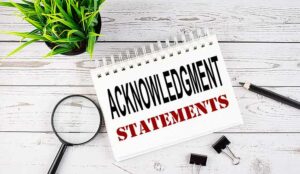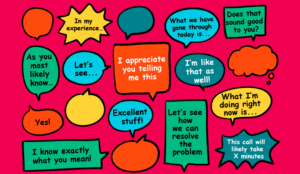Reassurance statements are key phrases used by contact centre agents to help customers feel confident that their issues will be resolved efficiently. These statements address customer concerns and reduce anxiety.
When used effectively, reassurance statements can also reduce escalation requests. We have put together reassurance statement examples for your advisors to use in your call centre.
What Are Reassurance Statements?
Reassurance statements are used by contact centre agents to help customers feel confident that their questions and issues will be resolved as efficiently as possible, removing the customer’s fear or doubt.
Get reassurance right and customer satisfaction rates will likely rise, while escalation requests will tumble.

“In a contact centre, customers don’t see you and that adds to their uncertainty of whether or not their concerns will be taken care of,” says Rea Alducente, Founder of Rea Ninja.
“Reassurance statements will make customers feel that they will get what they need.”
Please Note, reassurance statements are not the same as AER statements. They also differ from assurance statements.
10 Examples of Reassurance Statements for Customer Service
By using reassuring words and reassurance statements in customer service – just like those listed below – advisors can give customers the confidence that they will be able to resolve their query.
1. “Hi, You’re Through to John. I’m an Experienced Advisor in the Customer Services Team Here at [Insert Company Name]. How Can I Help You?”
From the opening call greeting statement, an advisor can offer immediate reassuring statements, confirming that the customer has reached the right person.
By introducing their job title, the advisor can establish their expertise, while also presenting themselves as being in a position of authority.
Note, advisors could also add how many years they’ve been at the company – if they are long-standing team members.
If you are looking to refresh your call centre scripts with great customer service greetings, read our article: The Best Customer Service Greeting Phrases – with Examples
2. “I’ve Come Across This Issue Before. What I Did to Resolve It Was…”
If the advisor mentions that the problem has cropped up before, they can subtly reassure the customer that there is an “oven-ready” solution to their issue.
This statement also enables advisors to highlight their expertise, so the customer feels confident that they’re in the best possible hands.
3. “Thank You. I’m Just Going to Repeat Back What You’ve Told Me, So We Can Be Sure That We’re on the Same Page.”
Once the advisor has used this statement, they can repeat back all of the important details and ask, “Did I miss anything?”
Such an approach, which is also known as “reflective listening”, can be hugely reassuring. This is because, very often, people perceive that they’re not being understood and, therefore, that the advisor won’t be able to help them.
However, by confirming mutual understanding, advisors can avoid such presuppositions.
For tried-and-tested customer service empathy statements, read our article: Empathy Statements for Customer Service
4. “I Realize That This is a Very Difficult Situation. But Don’t Worry, I Understand the Problem and You’re Through to the Right Person to Get this Sorted For You Today.”
By reaffirming that they are the right person for the job, the advisor enables the customer to grow in belief that a solution can be found.
By referencing time (e.g. today) advisors also reassure the customer that they can fix the problem in a timely manner.
Just be a tad careful with this. Advisors should only use a reassurance statement like this when they are confident in resolving the customer’s problem immediately. If not, they risk setting the wrong expectations and causing additional problems further down the line.
5. “I Can Help.”
Short and sweet, this statement reassures the customer that the agent is the right person for the query in hand. Again, this should only be used when agents are confident they really CAN help.
Discover lots more examples of power words that can take your reassurance statements to the next level by reading our article: The Best Power Words to Use in Customer Service
6. “I’m So Sorry to Hear This. It Shouldn’t Have Happened. I’ll Look Into This Right Away For You.”
Here, the approach is for the agent to recognize that there is a problem, which can help to reassure the customer that they are being taken seriously, while the words “right away” convey a sense of urgency in getting the matter resolved.
7. “There’s No Rush. Please Take as Long As You Need to Explain the Problem to Me.”
We all do it; when we’re nervous or upset, we can’t help but talk faster.

This statement encourages the customer to catch their breath, by reassuring them that the agent is listening to them and that no one is “clock watching”.
“Very often, when people are anxious, nervous or angry, their speech speeds up. This means that it’s difficult for the advisor to really understand what’s going on,” says Sandra Thompson, Founder of the EI Evolution.
8. “Thanks For Alerting Me to the Problem. I Can Understand Why You Feel [Insert Emotion]. Let Me Find a Solution to This.”
In this reassurance statement, [insert emotion] represents the words or feelings that the customer has expressed.
Reflecting the words or feelings that a customer uses can help to reassure them that the advisor was paying close attention. This statement also reassures the customer of a potential solution.
9. “We Can Solve This Together.”
Here the advisor reassures the customer that they are a team and it isn’t a case of “us” vs. “them”.
The use of the word “together” helps to involve the customer in the process of resolving the problem, which can go some way to making them feel less helpless and frustrated too.
10. “Yes”
“Ah-hum”, along with “Ah-ha…” and “Yes…”, are examples of verbal nods, which can make for great, bite-sized reassurance statements when used by an advisor – as it makes them sound more attentive.
Such nods reassure customers that they’re being listened to, as well as encouraging the customer to continue. This is important, as customers want to know that the advisor is present and engaged.
Printable – 10 Reassurance Statements for Customer Service
Do you want to download this to share with your team?
Get your free download of 10 Reassurance Statements for Customer Service now:
Top Tips for Showing Reassurance in Customer Service Conversations
Reassurance statements are designed to fill customers with confidence that their problem will be resolved. They therefore need to be authentic.
Here are some top tips to making reassurance statements as authentic and natural as possible.
Use “I” Instead of “We”
Encourage advisors to make reassurance statements more personal and thoughtful by asking them to refer to themselves as “I”.
This sounds simple, but often advisors use “we”, as in themselves and the organization. This comes across as very corporate and fails to establish a genuine connection with the customer.
Practise Your Statements Beforehand
The reassurance statements included in this article are best used as guidance, instead of being scripted, as advisors will feel more comfortable with some than others.
Asking advisors to read them out loud before using them in customer conversations will enable them to get a feel for which phrases work best. Using them in roleplay scenarios can also be a good idea.
Pay Close Attention to Tone of Voice
“Mind your tone of voice and ensure that it’s appropriate for the conversation,” says Rea. “The way you sound says a lot about the authenticity of your reassurance statements.”
Again, this comes back to the importance of active listening. If advisors listen closely to what the customer is saying, they can respond appropriately, in terms of both language and tone of voice.
For more tips on using tone of voice, read this article How to Utilize Tone of Voice in the Contact Centre
Build Up Advisor Confidence With the Product/Service
“In some cases, the insincerity of the reassurance is because either the advisor doesn’t know enough or they don’t have the confidence in the product/service themselves,” says Sandra.
“Advisors may feel like a phoney trying to offer reassurance when they know there’s going to be another problem cropping up very shortly.”
The issue of advisors not having much confidence in a product could be widespread, as they listen to complaints about it all day.
So, for some contact centres, it may be necessary to do some inside customer work to remind advisors of great customer experiences and bring them back to the purpose of the organization.
Final Thoughts on Reassurance Statements for Customer Service
If an advisor listens closely to a customer and demonstrates reassurance – using statements similar to those in this article – customer service will likely be greatly enhanced.
But try not to overthink this. When the advisor reflects back what they’ve heard and asks an intelligent question, this reassures the customer of their ability and that they have been listening.
What happens next is that there’s greater trust. This is important, as you can’t be reassured by someone if you don’t trust them.
The more trust a customer has in the advisor, the more likely it is that the customer will perceive that the issue will be fixed, making for a much better customer service conversation.
For more ways to create reassuring and positive customer conversations, read these article next:
- Positive Language for Customer Service Conversations
- Empathy Statements for Customer Service With Examples
- Assurance Statements in Customer Service – With Examples
Author: Robyn Coppell
Reviewed by: Jonty Pearce
Published On: 30th Jun 2023 - Last modified: 12th Feb 2025
Read more about - Skills, Language, Positive words, Rapport, Rea Alducente, Sandra Thompson, Soft Skills, Training




































